Abstract
Rock salt is characterized by specific geomechanical and rheological properties. Layers of rock salt at depths of over 900 m cause problems with shaft lining deformation. Methods of shaft lining protection used to date (e.g., in the Sieroszowice mine) have not been effective enough. The research presents a patented and copyright protected concept of a shaft lining construction that can be used in rock masses with strong rheological properties and susceptibility to leaching. A high value of convergence in salt rock mass is a reason for serious problems with shaft lining stability. Numerous trials have been done to provide appropriate shaft lining for salt layers, especially to ensure proper geometry of shaft members and conveyance guidance. In the new shaft lining concept, the excessive rock creep into the outbreak inside the shaft diameter is removed by local and controlled leaching of the shaft cheeks by means of fresh water through a porous medium at the contact layer behind the watertight tubing lining. The article presents the methodology of performing tests on a special device and the test results.
1. Introduction
The idea of the utilization of a typical salt property, high water solubility, is not new. Basically, the first historic method of salt production was the evaporation of salty water from springs, which are located in many places in the world [1,2,3,4]. Salt was gained from evaporation for thousands of years, not only from surface springs but also from underground leaks/leakages. Another method to produce salt was to dissolve rock salt in fresh water then evaporating it to get evaporated salt. Thus, the utilization of the salt’s water solubility and existing technologies of brine evaporation on an industrial scale is a logical consequence. The first attempts of large-scale salt leaching in Polish salt mines in Wieliczka and Bochnia took place in the 19th century. In the next century, salt leaching was a leading method of salt exploitation. There were three different methods of salt leaching in use: spraying salt walls with fresh water, leaching conducted in special leaching chambers and salt cavern leaching using boreholes. The borehole method, as the most modern and effective method, was broadly used and still is [2,5,6]. In the 20th century, salt caverns made this way were also considered for the convenient storage of hydrocarbons, hydrogen or other gaseous or liquid substances. Nowadays, many such storages are located in salt caverns made during the exploitation of salt deposits. Some caverns are made only to store substances in them, and brine is just a by-product [5,6].
Currently, salt leaching is done by boreholes with certain technical parameters and appropriate equipment. Water is pumped through the boreholes into the rock mass and dissolves salt. Fully saturated brine is pumped up back to the surface and directed to further processing. The significance of rock salt mining has decreased over the years as a consequence of its low price. However, the strategic importance of hydrocarbons and hydrogen cause a need for research and development works on cavern safety and excavation methods. One of the most important issues is the actual shape and dimensions of the cavern. Over the years, monitoring was almost impossible, but nowadays, many experiments are conducted to characterize those parameters, which have significant impacts on cavern safety [6,7,8,9]. The other important and tested field is the safety of tools used during cavern excavation and operation, such as pumps and insulation [6,7,8]. The effectiveness of salt cavern excavation is also a subject of works. In Poland, the use of high-pressure water jets was considered [5] as well as directional boreholes [7]. As the use of salt leaching for different purposes has marginal significance, research and development works are conducted only for the purposes of the storage of hydrogen, hydrocarbons and other substances.
Radioactive waste disposal is always a current problem, as well as a multidimensional issue, and because of the technical obstacles, it arouses very strong emotions of people. The solution to this problem is crucial, so very specific and high requirements are set for radioactive waste disposal [10,11,12,13,14,15,16]. It turns out that closed underground mines fit those requirements, especially closed salt mines. Actually, quite a lot closed mines are currently used for underground radioactive waste disposal, among them the Olkiluoto mine in Finland or the Asse and Morsleben salt mines in Germany [14,15,16]. As the safety of underground radioactive waste disposal is crucial and mine shafts are their only connection with the surface, the safety of those shafts is also essential, since their design, through every phase of their operation.
One of the most important issues of mine shaft stability in rock salt deposits is convergence. Convergence of the salt rock sidewall generates very strong pressure onto the shaft lining [17,18,19,20,21]. The convergence rate is an indicator that gives information on what action should be undertaken in order to reduce its destructive influence on the shaft lining.
As was proved by expert calculations and observations conducted on a section of a salt rock sidewall, salt rock rheological deformations can cause excessive loads on the final shaft lining in a relatively short time [22,23]. Modification of the shaft lining in a working shaft is rather impossible, with respect to the necessity of shaft operation stoppage for a long time period. Thus, the design of the shaft lining, ensuring removal of the creeping salt rock from the shaft, is necessary.
Multiple trials were done to ensure sufficient mine shaft stability in rock salt deposits. One of them is a very high load-bearing capacity steel lining [24,25], which is able to bear extreme pressure. There was also a proposal [26] to use yielding support that consists of a watertight lining and water column between it and shaft sidewall.
As the salt is easily dissolved in freshwater, the contact of salt rock on the whole surface of the shaft cheek with water introduced into the space between the lining and the shaft wall should be ensured in the new construction of the shaft lining. Saturated brine resulting from the dissolution process should be removed from the space of the shaft lining. As was proved by the experiments, stagnant water should be periodically replaced or thinned with fresh water, or recycled by laminar or turbulent water flow. Thus, the space between the shaft lining and shaft sidewall should be designed in such a manner to serve two functions:
- (a)
- enabling load transfer from the rock body onto the shaft lining,
- (b)
- enabling controlled freshwater flow behind the shaft lining.
A new construction of the shaft lining, called “tubing-aggregate lining”, consists of the following elements:
- Preliminary sidewall bolting protecting the shaft pipe during its sinking through the layer of salt.
- Tubing lining installed from the bottom to the top, which is supported by a shaft set (special technological ring) localized right under the bottom of the salt rock layer.
- Tubing of special construction, playing the role of technological rings (shaft sets) for individual sections of the shaft lining, of the length determined by examinations done on the testing section in one of the shafts sunk in this region.
- Filling with porous material—coarse-grained aggregate of high compression strength, allowing temporal washing of the salt rock sidewalls with fresh water or salt brine of a suitably selected concentration.
- Pipeline systems, pumps and containers for leaching medium and salt brine inflow and outflow.
The aggregate used in the described solution has a key task, as it must ensure contact between the salt rock body and shaft lining. Moreover, it should form a porous structure, which could be freely penetrated by a leaching medium. In addition, it plays the role of the deformable and equalizing layer for point loads.
2. Device for Salt Rock Leaching
A number of tests and analyses were planned in order to prove the assumed thesis. The first examination series additionally aimed at the verification of the device operation and calibration.
The differentiation of executed tests can be described by the following factors:
- (a)
- water temperature and salinity,
- (b)
- area of the sample’s cross-section and sample preparation procedure,
- (c)
- contact between the salt and aggregate,
- (d)
- character of the acting load,
- (e)
- volume of the leaching medium and flow characteristics.
Thirty of the most representative samples were selected and registered results were exposed to further analysis. Cube-shaped and rectangular-shaped samples were cut from the salt material. Sample cross-section dimensions were: 150 × 150, 100 × 100 and 50 × 50 mm. The frontal wall exposed to the leaching process was prepared to form a salt face, whereas the other surfaces were coated with waterproof paint or were left in their original state (Figure 1). The testing facility’s construction enables the testing of different sizes of samples.
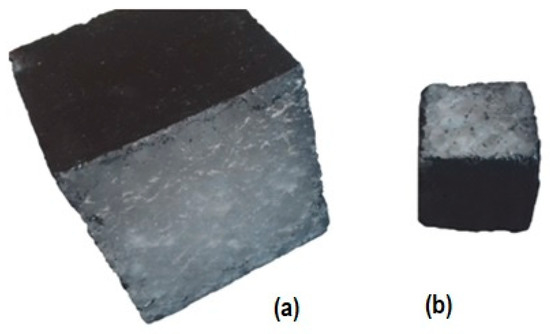
Figure 1.
Example of cube-shaped samples (a) 100 × 100 mm, (b) 50 × 50 mm.
The examinations were conducted in the device described in detail in other studies [27,28]. The mechanism of work of the device for salt rock leaching, as well as information showing the flow between individual components, are shown in Figure 2. Water flow forced by a pump is marked in blue. Temperature was controlled via a heater installed in the container, whereas flow discharge was registered by a suitable sensor. The system for loading (pump with servomotor) and the main chamber filled with salt and aggregate are shown in the central part of Figure 2. Data from individual modules were registered by notebook via suitable connectors. Besides, data acquisition image recording with the use of a time-lapse camera was conducted.
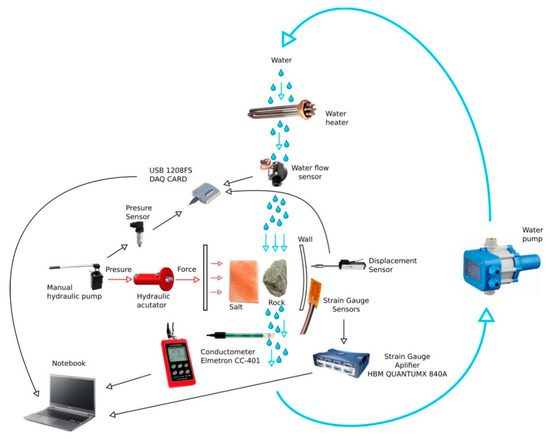
Figure 2.
Operation scheme of the measurement test device.
The testing compartment was made of a 12 mm thick steel sheet S355, and it was divided into open and closed parts. The closed part of the testing chamber is a sealed system equipped with a sleeve for hydraulic cylinder mounting. A hydraulic cylinder piston with a pressing plate puts pressure on the salt sample. The load is transmitted via the salt sample and aggregate onto the testing plate, where stresses and deformations are generated. Suitable values are measured by an extensometric converter and relocation transducer mounted at the measuring side of the testing chamber. Inflow and outflow valves allow control of the water flow direction and water discharge in the container. An overflow container with a capacity of 70 L allows water recirculation through the chamber–pumping unit–chamber system. A 3D model of the testing facility and a photograph of its compartments before assembly are shown in the picture below (Figure 3).
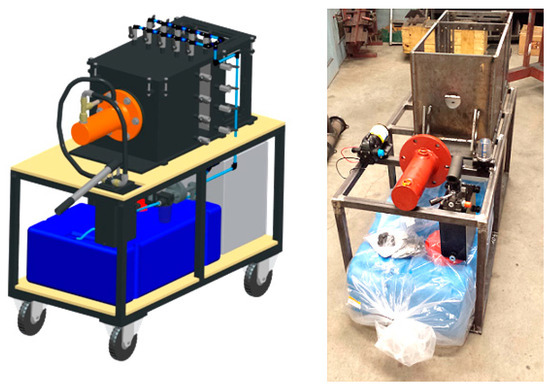
Figure 3.
3D model of the final version of the test facility and photograph of components before assembly.
The pumping system consists of a plastic filter, a membrane pump with a maximal discharge of 11.3 L/min and a flow meter and a set of valves: suction valve, inflow valve and outflow valve. Membrane pump construction ensures safe operation in a salt environment (internal part of the head is made of EPDM (ethylene propylene diene monomer) and Santroprene®, and the internal part is made of polypropylene) with a maximum pressure head of up to 10 m. Depending on the connection, the pumping system allows flow from the top or from the side of the testing chamber.
The hydraulic system comprises a manual hydraulic pump (max 250 bar), hydraulic pipes, a hydraulic cylinder and a hydraulic fluid pressure sensor. The system was designed to ensure pressure of 80 kN for maximum operation pressure (180 bar) of the pump.
To realize the designed experiment, the test facility had to be equipped with electromechanical accessories such as a pump and water heater. The application of additional electrical subsets was necessary to ensure safety of the operator and the test facility.
3. Examinations
Conducted examinations aimed at:
- (a)
- Confirmation that periodical leaching of salt rock sidewalls supported by coarse-grained aggregate stack is possible, and it allows effective control (reduction) of the shaft lining load.
- (b)
- Preliminary recognition of the processes related to the salt rock wall leaching and influence of the offloading process dynamics on the deformational pressure of the shaft lining.
Experiments proved that as a result of the dissolving process on the contact between salt and aggregate, a salt bridge is formed (Figure 4), whose shape, depending on the experiment characteristics, is similar to a truncated cone or pyramid. Tests were conducted to determine the cone development mechanism and its geometrical parameters.
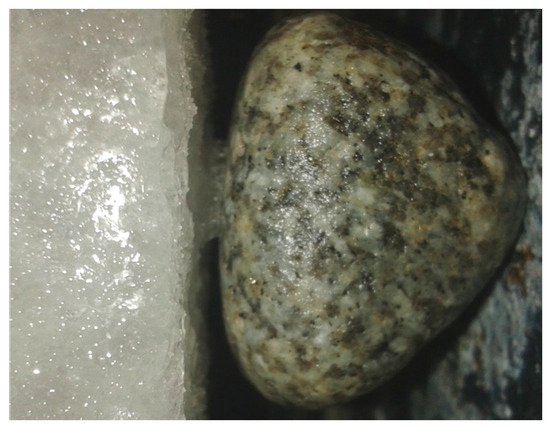
Figure 4.
Salt bridge on the contact between salt sample and individual aggregate grain.
Moreover, influence of the contact area between the sample and aggregate on the development of the salt bridge was observed. Thus, an attempt to simulate various contact characteristics of the salt wall with a single grain was undertaken.
In the next stage, on the basis of collected data, the rate of salt tenon (salt bridge) development was modeled. Experiments were conducted for three different-sized samples. In the initial moment, T = 0 surface was equal to 1 (100%) and during the washing process it was reduced until its destruction. A linear regression model of numerous variables was used in modeling, where the percentage of the surface occupied by the salt tenon was an explained variable and explanatory variables were: water temperature, water discharge per hour and time of the analysis. The square root of time was taken because it improved model tailoring and better described the examined phenomenon. The effect is visualized in graphical form in Figure 5.
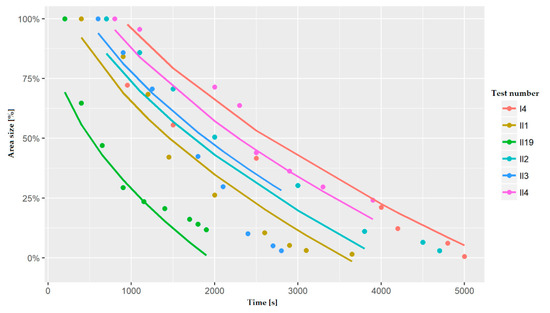
Figure 5.
Salt tenon surface over time for targeted parameters.
The salt rock wall dissolving model acting on some contact points where salt bridges are formed was developed according to the preceding experiments’ results.
Empirical formulas, shown below in descriptive and mathematical notation, were obtained:
where:
- a—percentage of salt tenon surface, %,
- t—time, s,
- T—temperature, °C,
- U—flow discharge, dm3/min.
The preceding formula was adapted to measurements, thus in time t = 0, 100% is not always obtained. This relationship presents general tendencies with respect to temperature and flow discharge, and it indicates the approximate time of growth of a salt tenon of a specified area.
As a result of this formula transformation, leaching time to achieve critical surface Acritical was obtained:
where:
Acritical—critical surface, mm2,
Awall—salt wall surface, mm2.
The ultimate relationship is as follows:
where:
- hS—salt tenon height, mm,
- vwall—sidewall advance rate, mm/day.
Factor P informs about the time (in days) needed to create salt tenons of critical surface, which are then destroyed with a rate adapted to the sidewall relocation. Leaching time is calculated from the former equation.
On the basis of the salt tenon height, the block wall flushing rate was determined. Similarly to the previous case, linear regression was applied. The salt rock leaching rate was assumed as constant and it was expressed as a ratio of the flushed salt height and its leaching time. Explanatory variables comprised flow discharge in liters per minute and temperature. It was observed that salt is also flushed out from the frontal tenon surface on the salt block contact with the obstacle. The height of the leached salt was about 20%. Data obtained in the experiment are shown below.
Accordingly, the empirical formula for the salt wall leaching rate was combined with the leaching time formula, which allows for the determination of dissolved salt height H (mm):
where:
Figure 6 illustrates the effects in graphical form.
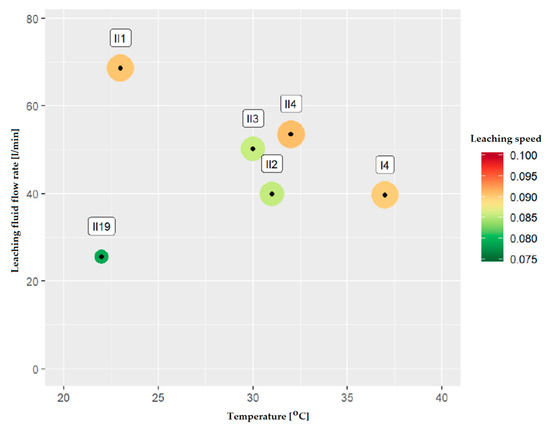
Figure 6.
Salt wall leaching rate with targeted parameters.
3.1. Analysis of Characteristic Fragments of a Single Sample
The first scenario of the analysis of the obtained results is composed of a comparison of characteristic courses of a single test sample. The drop in the force from the same initial value in a specified time range in sequential simulation cycles of the rock body creeping was examined.
- Analysis of test marked with symbol II.12
Basic information about the experimental procedure:
- (a)
- Pressing force of the salt block onto the shaft lining via a cylinder.
- (b)
- Leaching during measurements—process of the salt block washing with water in order to reduce the load.
- (c)
- Sample protection—salt block was covered with paint in order to allow dissolving of only one (unprotected) wall, which was in direct contact with the shaft lining.
- (d)
- Only measurements lasting 600 s with an initial value of the aggregate pile load of about 18 kN were chosen for the analysis.
Based on the functionality of the application developed for the needs of the analysis of the drop in the force loading on the salt lump, specified fragments of the data were removed from the full set of results and then put in the diagram in order to compare data. The result is shown in the diagram presented in Figure 7.
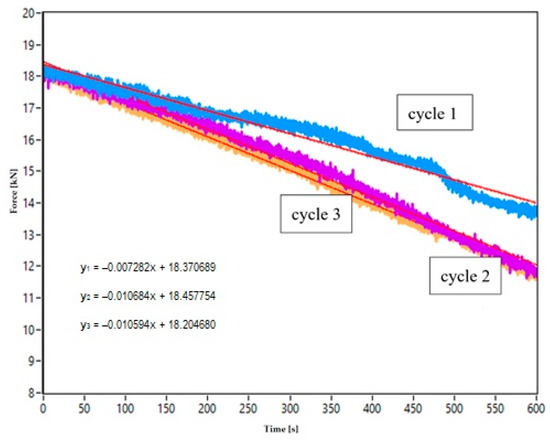
Figure 7.
Comparison of individual loading cycles; Blue line—cycle 1, purple line—cycle 2, orange line—cycle3.
Similar inclination angles of the straight line approximating the formation of the force loading of the shaft lining over time in subsequent leaching cycles can be observed in the diagram. The leaching rate, expressed with the tangent of the inclination angles of the approximation line, is low, which is the direct result of the initial water salinity (result of the previous test), despite the continuous dissolving process and constant water temperature amounting to about 36 degrees Celsius.
- Analysis of the test marked with symbol II.5
The experimental procedure was identical to the one presented for test II.12. Similarly to the previous case, fragments of the data were removed from the full data set and are shown in one diagram (Figure 8) for comparison.
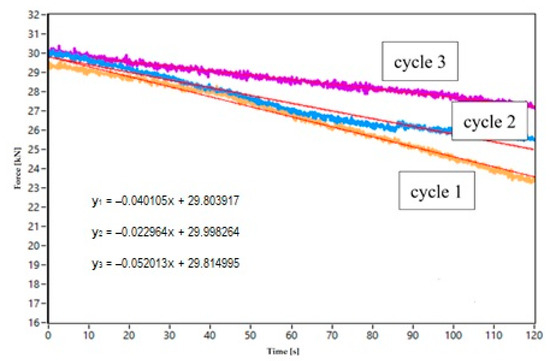
Figure 8.
Comparison of subsequent loading cycles; Orange line—cycle 1, blue line—cycle 2, purple line—cycle 3.
A variable angle of force approximation lines over time can be observed in the diagram above. The leaching rate is very high despite the high brine salinity, which is the result of previous tests. A high rate also results from salt sample protection on the sample’s sides, which was done in order to force leaching of the area simulating a rock mass which is in contact with the lining.
It was also observed that despite the cyclic leaching process and constant brine temperature of about 38 °C, the leaching rate was reduced in each subsequent cycle.
- Analysis of test marked with symbol II.8
The experimental procedure was the same as for the previous tests.
In the diagram (Figure 9), variable angles of inclination of the approximation lines of the force overtime are observed. The leaching rate is low (tangent of the inclination angle) despite the low level of the brine salinity—water was replaced before measurement.
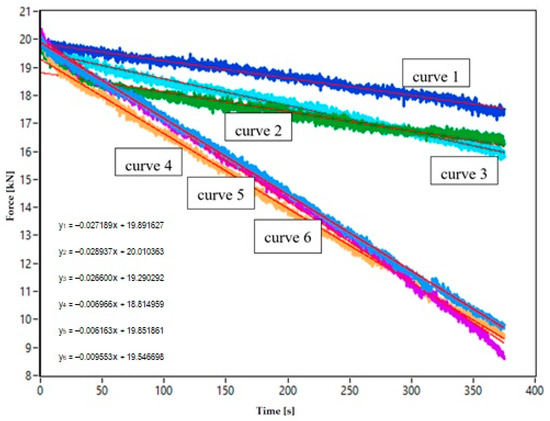
Figure 9.
Comparison of subsequent load cycles; Navy-blue line—cycle 1; green line—cycle 2, light blue line—cycle 3, orange line—cycle 4, purple line—cycle 5, blue line—cycle 6.
It was also noted that despite the cyclic leaching process, the leaching rate is reduced in each subsequent cycle (cycle 1, 2, 3) until the moment in which the leaching rate is almost equal for all cycles (cycle 4, 5, 6). This is caused by an increasing level of the leaching water salinity, as well as the low temperature of the leaching water (~20 degrees Celsius).
3.2. Analysis of Various Tests’ Characteristic Cycles
The next scenario of the result analysis comprises comparison of the characteristic fragment of the beginning of the research process. The analysis aimed at the load drop in the first phase of relaxation, directly after the load application. The following samples were considered:
- (1)
- II.5: pressing force applied to plate, fresh stagnant water,
- (2)
- II.7: pressing force applied to cylinder, leaching with salted water,
- (3)
- II.8: pressing force applied to cylinder, leaching with salted water,
- (4)
- II.9: pressing force applied to cylinder, leaching with salted water.
Measurements of the first load relaxation phase were chosen for the analysis, with an initial value within the range of 16–20 kN.
Test results from the measurements are shown in Figure 10. All samples were made from salt from the same location. The leaching water temperature was constant during all measurements (22 °C). It is observed in the diagram related to test II.5, that a small force value (about 16 kN) resulting from the stoppage of water flow and clamping force, caused the development of a large number of salt tenons and caused (threefold) elongation of the load relaxation time. Thus, we can conclude that the clamping force of the salt rock (directly and tightly) inserted into the shaft lining may cause retardation of the leaching process. The results of other samples’ tests confirm the correctness of the application of aggregate, used as an intermediate layer between the shaft lining and salt rock body.
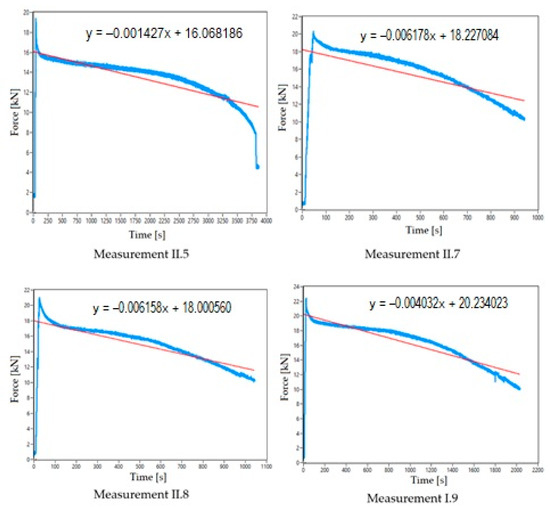
Figure 10.
Comparison of individual loading cycles; Blue line—actual data, red line—line of trend.
The tests II.7 and II.8 are similar. However, a higher rate was observed in the first case, where relaxation has a similar rate despite the fact that in test II.7, brine was replaced with fresh water. Thus, we can conclude that water salinity has no considerable influence on leaching rate.
In test II.9, elongation of the time of the first relaxation was observed. It resulted from an increase in the water salinity during tests II.7 and II.8. In the case of test II.9, leaching time was elongated, despite the active water circulation.
Another phenomenon that was analyzed was related to the destruction of the salt tenons in subsequent cycles of the rock body movements.
A graphical illustrations of the process of salt tenon destruction are shown in Figure 11 and Figure 12. Fragments of the results, in which a load caused rock body relocation after the leaching process, were selected from the measurement data. Curve 1 illustrates the course of the first cycle of sample loading, with noticeable fluctuations resulting from sample settlement in the test facility. Curves 2, 3, 4 and 5 (in the case of tests II.8 and II.9) comprise data from subsequent relaxation processes, in which destructive processes were observed.
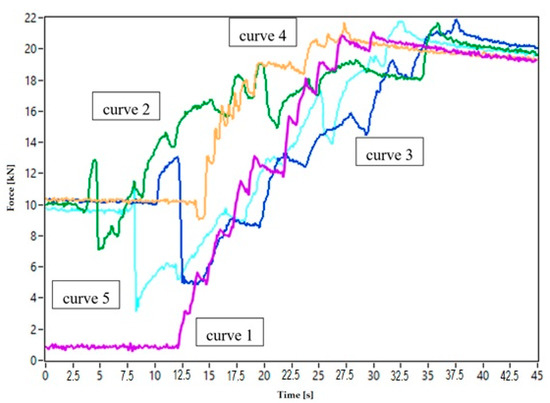
Figure 11.
Comparison courses of the salt tenon destruction in test II.8 of individual loading cycles; Purple line—curve 1, green line—curve 2, blue line—curve 3, orange line—curve 4, light blue line—curve 5.
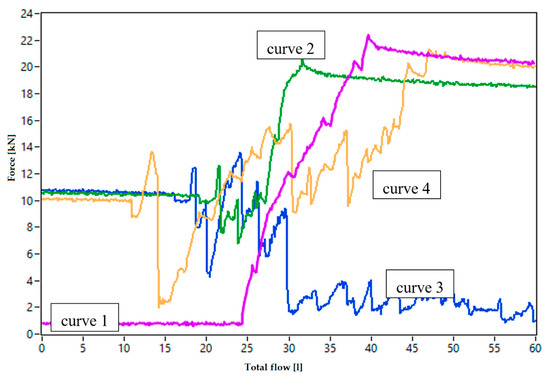
Figure 12.
Courses of the salt tenon destruction in test II.9; Purple line—curve 1, green line—curve 2, blue line—curve 3, orange line—curve 4, light blue line—curve 5.
The phenomenon of the salt tenon destruction can be observed in the diagram, in which the force course was replaced with its derivative. Local maxima and minima reflect dynamic changes occurring when the rock body pressed onto the shaft lining and salt tenons developed during the leaching process are not able to bear the compressive force and they are exposed to dynamic destruction. Maxima/minima of the beginning and the end of the measurement range result from errors of the numerical differentiation.
4. Conclusions
The issue of the stability of mine working in the salt rock mass is neither new nor not analyzed. The problem was discussed in numerous research studies and publications.
The prospect of further development of copper mining in Pre-Sudetic Monocline, as well as the advance of an exploitation front to the north, is related to the necessity of development of new works in the salt rock mass. These headings, as long-lasting ones, must guarantee rock body stability for decades. Shafts equipped with lifts must also provide consistent shaft structural member geometry, especially conveyance guidance, which provides the high speed of the lifts’ movement. Before works related to salt formations start, we should realize that issues of salt rock geomechanical behavior are very complicated and they differ from most other rocks. Each examined case should be based on the parameters of a given deposit.
An analysis of the literature and available data from research works allowed the following conclusions:
- Shafts built for the needs of KGHM Polska Miedź S.A. will penetrate salt rock body in sections of different lengths at a depth of about 1000 m.
- The shafts sections located in a salt rock mass will be exposed to convergence of a relatively high rate and relatively big relocation of the shaft sidewalls. After 4 years of sinking of the SW-4 shaft, the convergence of the shaft sidewalls is noted to be about 0.5 mm/day, so yearly dislocation of the shaft sidewall is about 18 cm.
- Yielding lining used in the SW-4 shaft can be used only because of the fact that the shaft has no lift and gradual dislocations of the shaft sidewalls play no considerable role, despite a decrease in the shaft cross section used for ventilation.
- Periodic reconstruction of the shaft section located in the salt rock mass is expensive and requires the stoppage of regular shaft operations, which generates very high costs and is a very complicated process.
- The application of similar solutions for the shaft lining is not possible in shafts equipped with lifts, because precise operation of the conveyances is required, in the case of both fixed and rope guidance.
The methods of the control of the shaft lining load via suitable construction and operation procedures, described in this work, utilize the biggest disadvantage of the salt rock mass, which is high solubility in fresh water. In this case, this rock property is considered as its greatest advantage.
Preliminary examinations conducted and documented in the present study proved that the process of controlled leaching of the salt sidewalls of the shaft opening is possible. The application of this process in practice should be a new tool used for the elimination of the deformation pressure exerted onto the shaft lining.
The designed test facility for salt rock leaching gave only basic answers to questions related to the described problem, whereas solutions for numerous technological questions require the application of large-scale models in situ.
The solution of such a complex problem proposed in this work requires further examinations related both to leached salt properties and forecasting and measuring rates of salt rock mass creeping into the shaft, as well as its effective and uniform leaching.
It should be emphasized that the results of the executed examinations indicate that after periodic leaching, grain filling of the contact layer can and should be voided from fluid (and brine). Thanks to that, the shaft tubing lining will not be additionally loaded with hydrostatic pressure coming from the brine, which is aggressive to construction materials.
The application of new construction solutions allows for the elimination of planned periodic reconstruction works. This results in the avoidance of shaft operation stoppage, which is crucial for the effectiveness of the mining shaft.
Funding
This research received no external funding.
Institutional Review Board Statement
Not applicable.
Informed consent
Not applicable.
Conflicts of Interest
The author declares no conflict of interest.
References
- Tijani, M.N.; Leohnert, E.P. Exploitation and traditional processing techniques of brine salt in parts of the Benue-Trough, Nigeria. Int. J. Miner. Process. 2004, 74, 157–167. [Google Scholar] [CrossRef]
- Jodłowski, A. Saltworks in Wieliczka (PL: Żupa Solna w Wieliczce); Muzeum Żup Krakowskich: Wieliczka, Poland, 2000. [Google Scholar]
- Danczyn, R. Dawne Tradycje Warzenia Soli Na Terenach Bojkowszczyzny, Studia i Materiały Do Dziejów Żup Solnych w Polsce, t. XXVIII; Muzeum Żup Krakowskich Wieliczka: Wieliczka, Poland, 2012. [Google Scholar]
- Gonet, A.; Brudnik, K.; Przybyło, J.; Stryczek, S.; Wolańska, A. Wieliczka Salt Mine. Saving the Monument (PL: Kopalnia Soli "Wieliczka”. Ratowanie zabytku), Kopalnia Soli “Wieliczka”; Trasa Turystyczna: Wieliczka, Poland, 2017. [Google Scholar]
- Korzeniowski, W.; Poborska-Młynarska, K.; Skrzypkowski, K.; Zagórski, K.; Chromik, M. Cutting niches in rock salt by means of a high-pressure water jet in order to accelerate the leaching of storage caverns for hydrogen or hydrocarbons. Energies 2020, 13, 1911. [Google Scholar] [CrossRef]
- Kunstman, A.; Poborska-Młynarska, K.; Urbańczyk, K. Overview of Borehole Salt Leaching (PL: Zarys Otworowego Ługownictwa Solnego); Wydawnictwo AGH: Kraków, Poland, 2002. [Google Scholar]
- Laskowska, T.; Gąska, K. New methods and technologies for leaching salt caverns for gas storing (PL: Nowe metody i technologie zastosowane w czasie ługowania komór przy budowie magazynów gazu zlokalizowanych w złożach soli). Nafta-Gaz 2010, 56, 356–361. [Google Scholar]
- Urbańczyk, K. Sources of knowledge about salt leaching (Process of salt cavern leaching part I) (PL: Źródła wiedzy o procesie ługowania kawern solnych (Proces ługowania kawern solnych cz. I)). Przegląd Solny 2015, 11, 32–43. [Google Scholar]
- Berest, P. The Mechanical Behavior of Salt and Salt Caverns, Rock Mechanics for Resources, Energy and Environment; Taylor & Francis Group: London, UK, 2013. [Google Scholar]
- Kalda, G. Radioactive Waste Management (PL: Gospodarka Odpadami Promieniotwórczymi), Zeszyty Naukowe Politechniki Rzeszowskiej; Budownictwo i Inżynieria Środowiska z. 59 (4/12); Oficyna Wydawnicza Politechniki Rzeszowskiej: Rzeszów, Poland, 2012. [Google Scholar]
- IAEA. IAEA Safety Standards for Protecting People and the Environment; Disposal of Radioactive Waste; International Atomic Energy Agency: Vienna, Austria, 2011. [Google Scholar]
- Freiesleben, H. Final Disposal of Radioactive Waste. Available online: https://www.epj-conferences.org/articles/epjconf/abs/2013/15/epjconf_lnes2012_01006/epjconf_lnes2012_01006.html (accessed on 24 October 2020).
- Claire, C.; Neil, H. Nuclear Waste Management; IOP Publishing: Bristol, UK, 2018. [Google Scholar]
- Institut de Radioprotection et de Surete Nucleaire. Radioactive Waste Management. Available online: https://www.irsn.fr/EN/publications/thematic/Documents/irsn_booklet_radioactive_waste.pdf (accessed on 24 October 2020).
- OECD and Nuclear Energy Agency. Management and Disposal of High-Level Radioactive Waste; OECD Publishing: Paris, France, 2020. [Google Scholar]
- «Working Panel Waste management» of VGB PowerTech e.V. Waste Disposal for Nuclear Power Plants; Brochure: Essen, Germany, 2012; Available online: https://www.vgb.org/vgbmultimedia/VGB_Brosch_Entsorgung_web_ENGL_-p-6422.pdf (accessed on 24 October 2020).
- Lotze, F. Steinsalz und Kalisalz; Gebrüder Berntraeger: Berlin, Germany, 1957. [Google Scholar]
- Schuppe, F. Untersuchungen über rheologische Eigenschaften von Salzgestein. Polska Akademia nauk. Prace Komis nauk Techn. Krakowie Gornictwo 1966, 12, 183–190. [Google Scholar]
- Höfer, K.H.; Thoma, K. Triaxial tests on salt rocks. Int. J. Rock Mech. Mining Sci. Geomech. Abstr. 1968, 5, 195–196. [Google Scholar] [CrossRef]
- Serata, S. Application of continuum mechanics to design of deep Potash mines in Canada. Int. J. Rock Mech. Mining Sci. Geomech. Abstr. 1968, 5, 293–314. [Google Scholar] [CrossRef]
- Ślizowski, J. Examination of rheological salt properties for purpose of gas storing in salt caverns (PL: Badania własności reologicznych soli kamiennej przy projektowaniu komór magazynowych gazu ziemnego w górotworze solnym). Prz. Gór. 2011, 5, 9–15. [Google Scholar]
- Flisiak, D. Examination of Rheological Processes in Salt Deposit During Uderground Gas Storing (PL: Badania Procesów Reologicznych W Górotworze Solnym Wywołanych Użytkowaniem Podziemnych Magazynów Gazu); Projekt Badawczy KBN Nr 5T12A 01722; 2005; unpublished work. [Google Scholar]
- Fabich, S.; Morawiec, P.; Soroko, K.; Szlązak, M. Problems with maintenance of shaft lining in the salt interval of SW-4 shaft in “Polkowice-Sieroszowice” copper mine. Prz. Gór. 2016, 72, 65–74. [Google Scholar]
- Jeremic, M.L. Rock Mechanics in Salt Mining; Balkema, A.A., Ed.; Brookfield: Rotterdam, The Netherlands, 1994. [Google Scholar]
- Klein, J. Stresses in sliding-shaft linings due to curvature. In Proceedings of the 3rd International Conference on Shaft Design and Construction, London, UK, 24–26 April 2012. [Google Scholar]
- Chudek, M.; Kleta, H.; Wojtusiak, A.; Chudek, M.D. Obudowa szybów w warunkach znacznych ciśnień deformacyjnych górotworu. Górnictwo Geoinżynieria 2009, 33, 87–90. [Google Scholar]
- Kamiński, P.; Cyran, K. Research Device for Lining Effort Measurements Located on the Large Depth in Rock Salt Layers. Salt Rev. Yearbook Polish Salt Min. Assoc. 2014, 10, 75–84. [Google Scholar]
- Kamiński, P. New Structure of Shafts Lining and Load Adjustment Method on Sections Located in a Salt Rock Mass. Ph.D. Thesis, AGH University of Science and Technology, Kraków, Poland, 2018. [Google Scholar]
Publisher’s Note: MDPI stays neutral with regard to jurisdictional claims in published maps and institutional affiliations. |
© 2020 by the author. Licensee MDPI, Basel, Switzerland. This article is an open access article distributed under the terms and conditions of the Creative Commons Attribution (CC BY) license (http://creativecommons.org/licenses/by/4.0/).